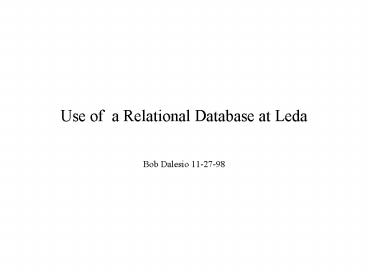Use of a Relational Database at Leda - PowerPoint PPT Presentation
Title:
Use of a Relational Database at Leda
Description:
Capfast is a very easy tool to use to define hierarchical systems - subsystem, ... the ease of channel check out and ability to reconfigure many channels at once. ... – PowerPoint PPT presentation
Number of Views:39
Avg rating:3.0/5.0
Title: Use of a Relational Database at Leda
1
Use of a Relational Database at Leda
- Bob Dalesio 11-27-98
2
Previous Approach
- Wiring diagrams in Access (RDB)
- Database in Capfast
3
Capfast Vs. RDB
- Capfast
- Graphical View of data
- Hierarchical creation/viewing
- Drawing to make relationships
- RDB
- Easy tabular report generation
- Arbitrary Query Capability
- Table entry to configure
4
Capfast Discussion
- Capfast is a very easy tool to use to define
hierarchical systems - subsystem, devices,
components. - Capfast uses lines to depict relationships
between these elements (these show record
processing and data flow very intuitively) - Many instances of the components can be created
with only one copy of the template - which can
be modified at any time - changing all instances - Fields like DTYP, LINR, EGUF, EGUL, ZNAM, ONAM
are all in property sheets that must be opened to
modify them - Changes to these fields require selecting each
property to modify - Arbitrary reports are not possible - unless the
ASCII report is fed into a relational database
(we have a prototype tool operational to do this)
5
RDB Discussion
- An RDB provides very versatile report generation
capability - Data entry is particularly easy - particularly
for entering the same value into many records at
the same time - The ability to order the report based on any
field makes the verification of hardware
addresses and the checking of name spelling
particularly simple - It is very difficult to see complex EPICS record
relationships by following the text entries in an
RDB - Data and processing links would be more difficult
to enter as names would need to be spelled
properly (where Capfast only requires a wire)
6
LEDA Vacuum System Approach
- Use Capfast to create the hierarchical
description of the database - subsystem, device,
component, signals - Use Capfast to configure the process flow and
data flow - making all SCAN, FLNK, soft INP/OUT,
NPP/PP, CALC, and HIGH for BO visible on the
schematic. - From the Capfast produced database - create an
Access database - In Access - enter configuration fields hw
INP/OUT, LINR, DTYP, EGUF, EUGL, ZNAM, ONAM etc. - Load the database from Capfast then the database
from Access - EPICS will create records if there
is no existing record - or overwrite any fields
in the last loaded database
7
Results
- Capfast database was defined by the project
engineer - RDB parameters were entered by a technician
- Reports generated for signal checkout from Access
expedited the process - Changes required to classes of channels for
labels, hardware type and engineering units could
be done to 10s or hundreds of records in seconds - Loading two databases slows the reboot time by
about 10 seconds. - Having the source in two places requires more
coordination. - Deleting or changing the names of existing
records was the most difficult operation - it
required locating and deleting the records in
Access - The inconvenience for deleting records was more
than compensated for by the ease of channel check
out and ability to reconfigure many channels at
once. The schematics are still the easiest way to
understand a database.































